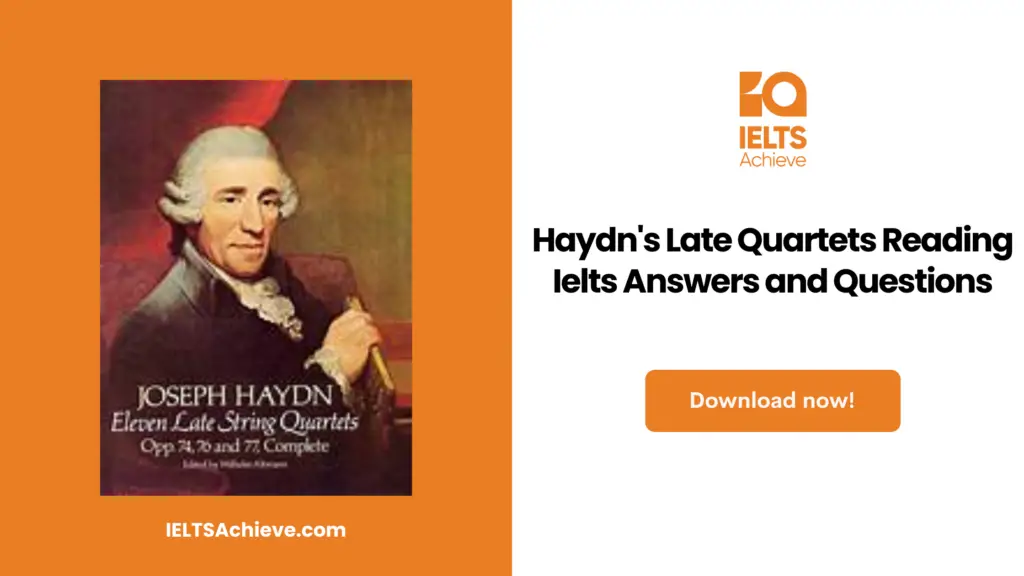The Blog post contains the following IELTS Reading Questions:
- IELTS Reading Yes/No/Not Given
- IELTS Reading Multiple Choice Questions
Stay informed and prepared for success – Explore our comprehensive Reading Test Info page to get valuable insights, exam format details, and expert tips for mastering the IELTS Reading section.
Haydn’s Late Quartets IELTS Reading Passage

Haydn’s Late Quartets
A. By the time he came to write the String Quartets published as Opus 76 and Opus 77, Haydn was undoubtedly the most famous living composer in the whole of Europe. He had recently returned from the highly successful second visit to England, for which he had composed his last six symphonies, culminating in the brilliant and festive Drum Roll Symphony (No. 103) and London Symphony (No, 104). This is public music, full of high spirits, expansive gestures and orchestral surprises. Haydn knew how to please his audience. And in 1796, following his return to Vienna, he began work on his largest and most famous choral work, the oratorio, “The Creation”. In the succeeding years, till 1802, he was to write a series of other large scales religious choral works, including several masses. The oratorios and masses were also public works, employing large forces for dramatic effect, but warm and full of apparently spontaneous religious feeling. Yet at the same time he composed these 8 quartets, in terms of technical mastery and sheer musical invention the equal of the symphonies and choral works, but in their mood and emotional impact far removed, by turns introspective and detached, or full of passionate intensity.
B. Once again, as in the early 1770s when he appears to have been going through some kind of spiritual crisis, Haydn returned to the String Quartet as a means to accomplish a two-fold aim: firstly to innovate musically in a genre-free from public performance requirements or religious convention; secondly to express personal emotions or philosophy in a musical form that is intimate yet capable of great subtlety and complexity of meaning. The result is a series of quartets of astonishing structural, melodic, rhythmic and harmonic variety, inhabiting a shifting emotional world, where tension underlies surface brilliance and calm gives way to unease.
C. The six quartets of Opus 76 differ widely in character. The opening movement of No. 2 is tense and dramatic, while that of No. 4 begins with the soaring long-breathed melody that has earned the nickname of “The Sunrise”. The minutes have moved a long way from the stately court dance of the mid-eighteenth century. The so-called “Witches Minuet” of No. 2 is a strident canon, that of No. 6 is a fast one-in-a-bar movement anticipating the scherzos of Beethoven, while at the heart of No. 5 is a contrasting trio section which, far from being the customary relaxed variant of the surrounding minute, flings itself into frenetic action and is gone. The finales are full of energy and grace. We associate with Haydn but with far less conscious humour and more detachment than in earlier quartets.
D. But it is in the slow movements that Haydn is most innovative and most unsettling. In No. 1, the cello and the first violin embark on a series of brusque dialogues. No. 4 is a subdued meditation based on the hushed opening chords. The slow movements of No. 5 and No. 6 are much looser in structure, the cello and viola setting off on solitary episodes of melodic and harmonic uncertainty. But there the similarity ends, for while No. 5 is enigmatic and predominantly dark in tone, the overlapping textures of its sister are full of light-filled intensity.
E. The Opus 76 quartets were published in 1799 when Haydn was well over 60 years old. Almost immediately he was commissioned to write another set by Prince Lobkowltz, a wealthy patron, who was later to become an important figure in Beethoven’s life. Two quartets only were completed and published as Opus 77 Nos. 1 & 2 in 1802. But these are not the works of an old man whose powers are fading, or who simply consolidates ground already covered. Once again Haydn Innovates. The opening movement of Opus 77 No. 2 is as structurally complex and emotionally unsettling as anything he ever wrote, alternating between a laconic opening theme and a tense and threatening counter theme which comes to dominate the whole movement. Both quartets have fast scherzo-like “minuets”. The slow movement of No. 1 is in traditional variation form but stretches the form to the limit in order to accommodate widely contrasting textures and moods. The finale of No. 2 is swept along by a seemingly inexhaustible stream of energy and inventiveness.
F. In fact, Haydn began the third quarter in this set but never finished it, and the two completed movements were published in 1806 as Opus 103, his last published work. He was over 70 and clearly lacked the strength to continue composition. The two existing movements are a slow movement followed by a minute. The slow movement has a quiet warmth, but It is the minuet that is remarkable. It is in true dance time, unlike the fast quasi-scherzos of the earlier quartets. But what a dance in a sombre D minor Haydn unfolds an angular, ruthless little dance of death. The central trio section holds out a moment of consolation, and then the dance returns, sweeping on relentlessly to the final sudden uprush of sound. And then, after more than 40 years of composition the master falls silent.
Unlock your full potential in the IELTS Reading section – Visit our IELTS Reading Practice Question Answer page now!
Recommended Questions:
Renewable Energy IELTS Reading Question with Answer
Questions
Questions 1-3
Choose the appropriate letters A-D.
Write them In Boxes 1-3 on your answer sheet.
1. Which one of the following statements Is true?
A. Haydn wrote the London Symphony In England
B. We do not know where Haydn wrote the London Symphony
C. Haydn wrote the London Symphony in Vienna
D. Haydn wrote the Drum Roll Symphony in England
2. Like symphonies 103 and 104, the oratorios and masses were …
A. written in the eighteenth century
B. for the public
C. as emotional as the quartets
D. full of religious feeling
3. The string quartets in Opus 76 and Opus 77 were …
A. the cause of a spiritual crisis
B. intimate yet capable
C. calm unease
D. diverse
Ready to improve your performance in Multiple Choice Questions (MCQs)? Click here to access our comprehensive guide on how to tackle MCQs effectively in the IELTS Reading section.
Questions 4-9
Complete the text below, which is a summary of paragraphs 3 and 4 in Reading Passage 3.
Choose your answers from the word list below.
Write them In boxes 4-9 on your answer sheet.
There are more words and phrases than spaces, so you will not be able to use them all. You may use each word or phrase only once.
The six quarters of Opus 76 are very 4._______. For example, the opening of “The Sunrise” is not nearly as high as 5.______ as that of No.2.6.________ those of the mid-eighteenth century, the minutes are more frenetic and less relaxed. It is in the slow movements, however, that Haydn tried something very different. In contrast to No.4,No,1 if much 7._____ brusque, the former being much 8._____, 9.______, Nos. 5 and 6 are alike in some respects.
Word List
- Wide
- less
- different
- more
- long-breathed
- unlike
- similarly
- Subdued
- tense
- like
- conversely
- quieter
Questions 10-13
Do the statements below agree with that information in Reading Passage 3? In Boxes 10-13, write:
- YES, if the statement agrees with (the information in the passage
- NO, if the statement contradicts the information In the passage
- NOT GIVEN, If there Is no Information about the statement in the passage
10. Haydn was well-known when he wrote Opus 76.
11. Before the Opus 76 quarters were published, Haydn had been commissioned to write more.
12. The writer says that Opus 103 was Haydn’s last published work.
13. The writer admires Haydn for the diversity of the music he composed.
Want to excel in identifying the writer’s views and claims? Click here to explore our in-depth guide on how to accurately determine Yes, No, or Not Given in the IELTS Reading section.
Unlock your full potential in the IELTS Reading section – Visit our IELTS Reading Practice Question Answer page now!
Recommended Questions:
Renewable Energy IELTS Reading Question with Answer
Answers for Haydn’s Late Quartets
1. Answer: B
2. Answer: B
3. Answer: D
4. Answer: Different
5. Answer: Tenie
6. Answer: Unlike
7. Answer: More
8. Answer: Quieter
9. Answer: Conversely
10. Answer: Yes
11. Answer: No
12. Answer: Yes
13. Answer: Yes

We hope you found this post useful in helping you to study for the IELTS Test. If you have any questions please let us know in the comments below or on the Facebook page.
The best way to keep up to date with posts like this is to like us on Facebook, then follow us on Instagram and Pinterest. If you need help preparing for the IELTS Test, join the IELTS Achieve Academy and see how we can assist you to achieve your desired band score. We offer an essay correction service, mock exams and online courses.

